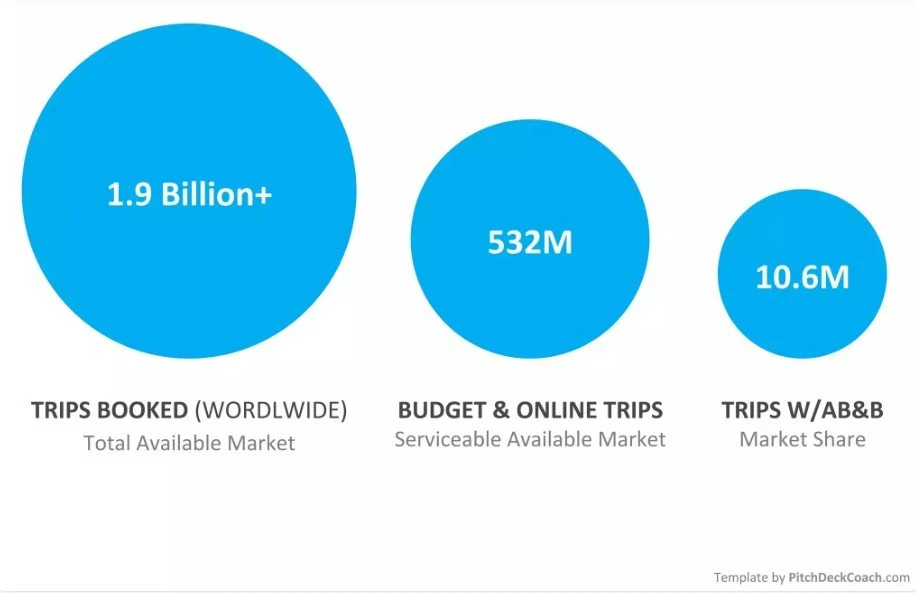How to Analyze TAM, SAM, and Market Share Like Airbnb
Airbnb Understanding and presenting your market opportunity is crucial when pitching to investors. Airbnb's pitch deck, which helped propel them into unicorn status, is a great example of how to communicate the size of your market, your target audience, and your current market share. In this post, we'll break down the three key metrics that every startup should include in their pitch deck: Total Addressable Market (TAM), Serviceable Available Market (SAM), and Market Share.
What Are TAM, SAM, and Market Share?
Total Addressable Market (TAM): TAM represents the total revenue opportunity if a company were to achieve 100% market share in a particular market. It’s the broadest measure of potential, reflecting the total size of the global or regional market for a product or service. For Airbnb, this included all trips booked worldwide, regardless of customer segment, estimated at 1.9 billion trips.
Serviceable Available Market (SAM): SAM narrows the TAM down to a more specific, reachable segment of the market that your business can realistically target. In Airbnb’s case, their SAM focused on budget-conscious travelers and those who booked trips online, which came to 532 million trips. SAM is important because it shows investors that you’ve clearly identified who your core audience is and how you plan to serve them.
Market Share: Market Share is the percentage of the SAM that your company currently controls. This shows how well you're performing within the market you’re targeting. For Airbnb, their market share was 10.6 million trips, indicating that they had captured a small but significant portion of their serviceable market.
Breaking Down Airbnb’s Slide
Airbnb's Pitch Deck Slide- TAM, SAM, and Market Share.
Airbnb presented these three metrics visually in their pitch deck using three circles of varying sizes. This visualization not only made the information easier to digest, but it also highlighted the growth potential in a clear and compelling way.
TAM was represented as the largest circle (1.9 billion trips), showing the vast size of the global travel market.
SAM was the medium-sized circle (532 million trips), narrowing down to the budget and online trips segment.
Market Share was the smallest circle (10.6 million trips), demonstrating the current number of trips booked via Airbnb.
This visual approach is effective because it immediately shows investors the scope of the opportunity, as well as how much market potential is still available for the company to capture.
Your Turn!
Now that we've seen how Airbnb did it, let's go over how you can calculate and present these metrics for your own business.
Step 1: Calculating Total Addressable Market (TAM)
To calculate your TAM, you need to estimate the total demand for your product or service. You can do this by:
Identifying your target market: Are you targeting a global or local market?
Estimating the number of potential customers: How many people or businesses need your product?
Multiplying by the price of your product: Multiply the number of customers by the price to get the overall revenue potential.
Example: If you're in the food delivery business, your TAM might be the total number of food deliveries made in your target region, multiplied by the average order value.
Step 2: Narrowing Down to Serviceable Available Market (SAM)
Your SAM should focus on the segment of the market that you can realistically reach in the near term, given your product offering, resources, and go-to-market strategy.
Identify your core audience: Narrow your TAM down to the customers most likely to use your product.
Segment the market: If you’re in the food delivery business, your SAM might focus on online food deliveries within a specific city, targeting young professionals.
Step 3: Defining Your Market Share
Market Share shows how much of the SAM you’ve already captured. To calculate your market share:
Divide your revenue by the SAM: This will give you the percentage of the market you currently control.
Present the growth potential: Investors will want to see that you’ve captured a portion of the market and that there is still significant room for growth.
Example: If your current revenue is $1 million and your SAM is $50 million, your market share is 2%. Showing this growth potential is key to convincing investors of your future success.
______
Breaking down TAM, SAM, and Market Share like Airbnb can give you a powerful narrative in your pitch deck. Investors need to see not only the size of the opportunity but also the specific market segment you're targeting and how well you’re performing within that segment. By clearly calculating and presenting these metrics, you demonstrate that your startup has room for growth and is well-positioned to scale.


